
Orivesi is a town in Finland, located in the Pirkanmaa region. It lies to the northeast of the regional capital, Tampere. The population of Orivesi is approximately 9,000, while the metropolitan area has a population of approximately 417,000. It is the 112th most populous municipality in Finland.
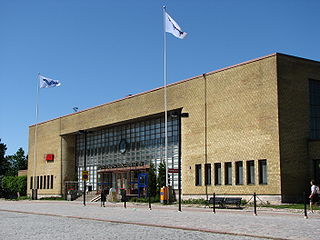
Turku Central Station is a railway station in the VII District of Turku, Finland. It has VR services to Helsinki and towards Joensuu. The station serves approximately a million passengers annually.

Tampere Central Station is a functionalist building in Tampere, Finland, designed by Eero Seppälä and Otto Flodin, completed in 1936. The station is one of the most important railway stations in Finland. In 2015, the Tampere Central Station was the second busiest railway station in Finland in terms of numbers of passengers, after the Helsinki Central Station.

Haapamäki railway station is a junction station in the village of Haapamäki, in Keuruu, Finland. Construction on the railway line from Tampere to Seinäjoki via Haapamäki was finished in 1882. When the railway line to Jyväskylä was built, Haapamäki became a junction station. The fourth line to branch off from Haapamäki was the Pori line, which was built in the 1930s.

The Lahti railway station is located in the city of Lahti in Finland.
The history of rail transport in Finland began on January 31, 1862, with the opening of the railway line between Helsinki and Hämeenlinna. By 1900 most of the future main lines had been constructed, including the line to St. Petersburg. By the time of the birth of the new Finnish Republic in 1917 lines connected all major cities, major ports, and reached as far as the Swedish border, and inner Finland as far north as Kontiomäki in Paltamo region, as well as eastwards into Karelia.
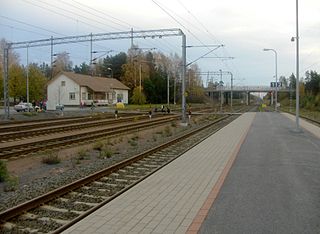
The Tampere–Pori railway is a railway running between the cities of Tampere and Pori in Finland. The line carries passenger traffic from Tampere to Pori via five railway stations and continues as a freight line to the Port of Pori. Tampere–Pori railway was opened in 1895 and the line follows the river Kokemäenjoki.

The Battle of Länkipohja was a Finnish Civil War battle fought in the village of Länkipohja on 16 March 1918 between the Finnish Whites and the Finnish Reds. Together with the battles fought in Kuru, Ruovesi and Vilppula between 15 and 18 March, the Battle of Länkipohja was one of the first military operations related to the Battle of Tampere, which was the decisive battle of the Finnish Civil War. The battle is known for its bloody aftermath as the Whites executed 70–100 capitulated Reds. One of the executions was photographed and the images have become one of the best known pictures of the Finnish Civil War.
Länkipohja is a locality in Jämsä, Finland, located by the lake Längelmävesi. It was the administrative center of the municipality of Längelmäki, which was divided between Jämsä and Orivesi in 2007.

The Hikiä railway station is located in Hausjärvi, Finland, in the village and urban area of Hikiä. It is located along the Riihimäki–Lahti line, and its neighboring stations are Riihimäki in the west and Oitti in the east.
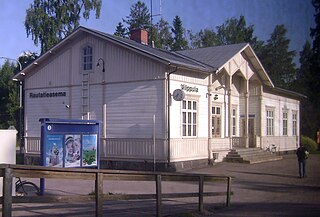
The Vilppula railway station is located in the town of Mänttä-Vilppula, Finland, in the district and former municipality of Vilppula. It is located along the Tampere–Haapamäki railway, and its neighboring stations are Kolho in the north and Orivesi Central in the south.
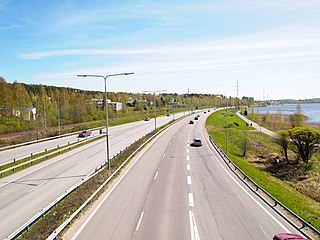
The Finnish national road 9 is a main route. It runs from Turku through Loimaa, Tampere, Jämsä, Jyväskylä, Kuopio, Outokumpu and Joensuu to the Niirala border guard station in Tohmajärvi, right next to the Russian border. The length of the road is 663 kilometres (412 mi).

The Kangasala railway station is a closed station located in the town of Kangasala, Finland, in the district and village of Asema. It was located along the Tampere–Haapamäki railway, and its nearest open stations are Tampere in the southwest and Orivesi in the northeast.

The Korkeakoski railway station is a railway station located in the municipality of Juupajoki, Finland, in the municipal seat and urban area of Korkeakoski. It is located along the Tampere–Haapamäki railway. Korkeakoski has only served freight transport since 1990; in 1998, the Juupajoki halt, located approximately 1.35 kilometres (0.84 mi) to the south from Korkeakoski, was opened to serve passenger transport in the area.

The Lyly railway station is a closed station located in the municipality of Juupajoki, Finland, in the village of Lyly. It was located along the Tampere–Haapamäki railway, and its nearest open stations are Korkeakoski and Juupajoki in the south and Vilppula in the north.
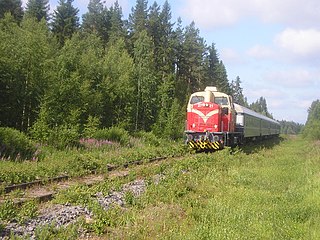
The Haapamäki–Seinäjoki railway is a railway running between the Haapamäki railway station and the Seinäjoki railway station in Finland. It is part of the historical Tampere–Vaasa railway; its other segments as known today include Tampere–Haapamäki and Seinäjoki–Vaasa.

The Pihlajavesi railway station is located in the town of Keuruu, Finland, in the village of Pihlajavesi. It is located along the Haapamäki–Seinäjoki railway, and its neighboring stations are Haapamäki in the south and Myllymäki in the north.

The Myllymäki railway station is located in the town of Ähtäri, Finland, in the village of Myllymäki. It is located along the Haapamäki–Seinäjoki railway, and its neighboring stations are Pihlajavesi in the south and Eläinpuisto-Zoo in the north.

The Orivesi–Jyväskylä railway, also called the Jämsä railway is a 1,524 mm railway in Finland, running between the Orivesi and Jyväskylä stations.

The Savonia railway is a five-foot-gauge railway in Finland. Beginning at Kouvola, it connects southern Finland with the eastern regions of South Savo and North Savo via the cities of Pieksämäki, Kuopio and Iisalmi.



















